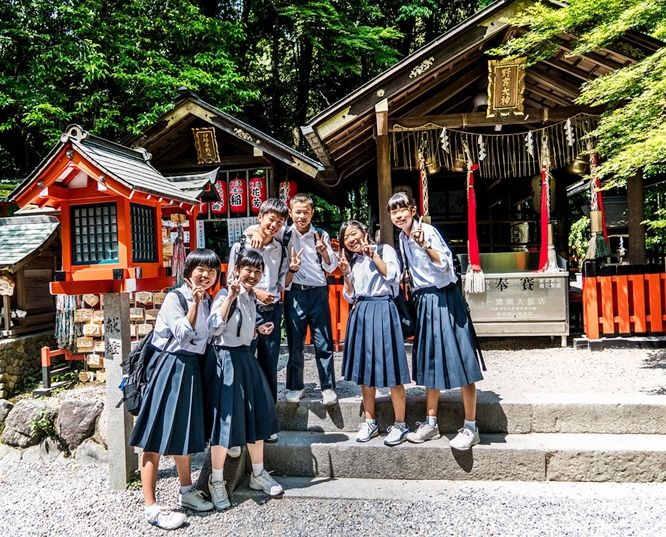
What to Wear Teaching English in Japan
When I decided to apply for teaching jobs in Japan a couple of years ago, one of the things I quickly found out about was the dress code for teachers in Japanese schools.
That’s because, after teaching in Thailand for seven years, I was used to wearing somewhat conservative dress as a female teacher at any school or business I taught in, and was interested to see if the clothing I already owned would be sufficient, or if an entirely new wardrobe would have to be bought.
Interestingly, even though I already do have a wardrobe full of conservative clothing for teaching in Thailand, Japanese schools are even more conservative, That meant I would have to add various items to my wardrobe if I did accept a teaching job at a Japanese school, so that I would fit in with the culture there.
If you would like to teach in Japan and are not sure what the dress code is like, coming from North America, Europe, Australia or New Zealand, you will probably find it’s even more conservative than you expect. Here is how you will be expected to dress in most Japanese classrooms, as well as tips on what your general appearance should look like.
Suits for men and women – In my seven years teaching English in Thailand, I have never been asked to wear a suit in the classroom. In Japan, however, this is common in many schools — from public and private day schools to language schools and, of course, if you teach at the business English level.

That means, for anyone planning on teaching in Japan, you will need to take at least three suits with you to have enough clothing to teach in a Japanese classroom for a year. Buying suits to fit you will be difficult in Japan as many Japanese men and women are shorter and thinner than many westerners, and having a suit tailored is expensive, so you want to make sure you have enough before you leave.
Related: How to interview for a teaching job in Japan and get it
Shirts worn underneath them should also be cut well and conservatively colored, with a white shirt being the most often chosen color.
Ties for men – Ties should also be in conservative colors, as the Japanese tend to be quite muted in the colors they wear. That means you don’t want to stand out wearing a bright red floral tie, or one with Bugs Bunny on it, when every male Japanese teacher around you is wearing something in a muted shade of blue.
Take a few conservative ties with you, as you can always buy something a little wilder later on if your school seems to allow it.
Dress code for female teachers in Japan – As everywhere else in Asia, women teachers should not wear sleeveless shirts, anything low cut that shows your cleavage, or an unpadded bra as visible nipples are a no-no.
Shirts that button high up at the neck are the best as, don’t forget, in Japanese culture you will be expected to bow in certain situations and showing even a hint of cleavage at these moments is not culturally acceptable.
Related: Is it possible to do freelance teaching in Japan and can you make money at it?
Skirts too should be at a conservative length, meaning nothing above the knee and, if at all possible, preferably an inch or two below it. Some schools allow their female teachers to wear pants, some do not, so check before you arrive. Jeans, however, are rarely allowed.

Hair – For men, hair should be nicely styled and cut short even if you think you look better with longer hair.
A friend who left Thailand for a teaching job in Japan arrived at his new school wearing a suit and with his usual shoulder-length hair in a ponytail. He was immediately told to “cut it or don’t come back”. Some schools will allow men to have longer hair as long as it is clean and tidy, but this is rare so you may just want to have it cut before you leave.
Related: How to apply for a job teaching English in Japan in a few easy steps
For women, however, the length of your hair isn’t an issue. You can have it long or short, worn up or down, although it should be clean and tidy no matter which style you choose. As for dyed hair, if you currently have purple, pink or blue hair, even in streaks, make sure to color it back to your normal color before arriving at your Japanese school as it’s not acceptable anywhere.
After all, teachers in Japan are supposed to be respected and not look like an overgrown punk rocker.

Make-up and perfume – During one of my interviews for a teaching job at a Japanese school, I was told by the western interviewer that, if I was offered the job and accepted it, not to wear noticeable make-up or any perfume.
As I don’t wear either, that didn’t worry me at all, but it may be a problem for women who do. Make-up, unless just the lightest mascara, lip gloss or pale lipstick isn’t acceptable, and neither is any kind of perfume.
Nail polish too is a no-no.
Shoes – For men, conservative slip-on or lace-up shoes in black, brown or grey are acceptable. For women, many schools will not allow open-toed shoes or sandals. Some will also expect you to wear hose with your shoes, even in the heat of the summer.
Tattoos – Finally, if you have tattoos anywhere, you must cover them up at all times. If that means always wearing a long-sleeved shirt or a high-necked blouse, or having a cover-up make up on a tattoo on your ankle, it must be done every day. Tattoos are absolutely taboo at any Japanese school and showing up visibly sporting one will be frowned upon.
Just like teaching in any Asian country, the dress code in Japan for teachers is far more conservative than anything you have ever been used to. The best rule of thumb is to show up for work during your first week wearing the most conservative clothing possible, as nobody is going to criticize you for that.
You can then liven things up as the days go by, simply be watching what every other teacher wears and doing the same.
Meanwhile, for more information about appropriate dress codes for women in Japan, there’s an interesting discussion on the JET Forum.
